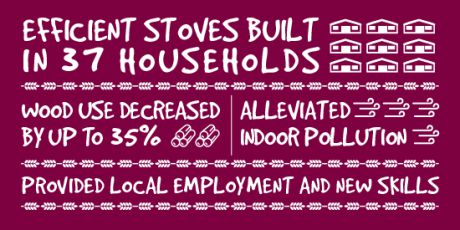
Project Background
PeAk is a small organisation striving to advance primary school education and implement alternative technologies in the Kumaon region, India. In 2015/16 PeAk, funded by World Nomads customers through the Footprints Network, implemented a fuel efficient stove project. After extensive community consultation and research into stove (Hindi – chulha) design, PeAk identified a trial site in the village of Jatoli at 2400m. This project was designed to improve overall householder health and lessen the ecological foot print of using fuel wood in an open hearth which is centrally located in a traditional house for both cooking and heating at a high altitude.
Project Details
PeAk staff had one household that was willing to be the ‘guinea pig’ and so the first stove was built thanks to Hookum & Lacchima. Over a period of time, fellow villagers came to assess the stove over many cups of tea; coupled with community education, cultural barriers were overcome and perceptions shifted. Suddenly women were talking about stoves, impromptu community meetings were often held at the local ‘chai’ (tea stall) and word came to us in Khati (7km away) that every householder was interested in a stove! The first thought was ‘no – it isn’t possible’ as PeAk staff were aware that global uptake has been mixed; just ask Hillary Clinton, stoves were her ‘pet project’ when she was foreign secretary.
Over a period of time PeAk had trialed various chulha designs. After community scrutiny, the current design was ‘fine-tuned’ for local conditions. The total number of stoves ordered after consultation with the all male ‘community elders’ was 22. However, solo and or elderly women and newlyweds had been omitted, go figure! Understandably, Sauruli, a strong elderly woman, protested and subsequently conducted a house to house audit and revealed a total figure of 37 chulhas. Sauruli had the “I told you so” look!
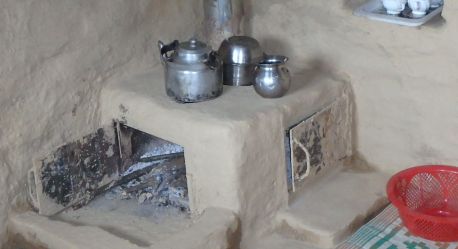
The community were involved in every facet you could imagine; from transportation and choosing the ‘stove builders’ to cementing around the flue on stone roofs, cutting out tin circles for a kettle or pot when not in use and nailing UV stable plastic on the small windows so the room remained light but was kept warm during the daytime. All done in a jovial environment over copious cups of chai that fostered amazing community responsibility. A huge thank you must go to Dinesh and Digember whom were diligent in stove construction and alleviated much of the stress for the project coordinators with their eclectic skill set.
The women render their stoves with red clay (and loving care) every few days, adding to the sense of ‘ownership’ through maintenance. Long term benefits include a 30% decrease in wood collection freeing up time for other pursuits and, in the short term, not being choked by smoke particularly when standing up and warmth in a room away from the fire. Jatoli villages are true ecosystem people with many natural products sourced from the temperate rain forest, hence an indirect effect on fuel efficient stoves is the preservation of these temperate and diverse systems. The deleterious effects of smoke inhalation is difficult to quantify but it is envisioned that decreased particulate matter (PM 2.5 & 10), a known carcinogen, will alleviate respiratory disease over the long term. And for the first time in our history of working in the region windows and doors were closed and we could see our hosts at dinner!
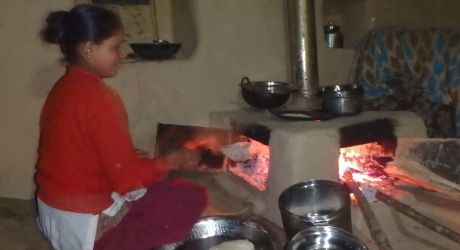
Key Project Outcomes
- All 37 households in Jatoli have chulhas installed and in use.
- 8mm plate steel for the doors, 6mm angle iron for the frames (7kg per unit) and 3mm galvanised sheet metal for the flue ensure good thermal mass, minimal maintenance and a long life span.
- Wood use is up to 30-35% less when the stove is used effectively, thereby lightening the work load of women and girls in wood collection and preserving the local temperate rain forest.
- Alleviating indoor air pollution will ameliorate health ramifications from wood smoke exposure.
- This project provided local employment - metal fabrication, transportation by jeep and mule through to stove construction - from start to finish, thereby helping the regional and local economy.
- The new skill set gained through this project will be utilised on future stove projects in the region.
- Use of local stone in the design enhanced thermal efficiency by re-radiating heat.
- The new chulhas have reduced the risk of childhood burns.
- In line with the Millennium Development Goals, the improvement of indoor air quality promotes environmental sustainability through less fuel wood use, frees up time spent in wood collection for other income generating pursuits (or in the case of Jatoli – some rare ‘non work’ time), reduces child mortality and improves maternal health (WHO 2014)
What's Next?
This project will be monitored at 6 &12 months intervals to ensure the stoves are effectively functioning. Building on the success of the installation of the Jatoli wood efficient stoves PeAk will expand this project in the district to approximately 50 more households in the next phase.
Throughout this (and prior) projects PeAk has developed a strong community network within the region, leading to a solid understanding of the issues facing those in remote Himalayan locations. This will enhance on the ground solutions to everyday needs in future projects.
PROJECT
This project plans to bring 23 fluepipe wood efficient stoves (chulha’s) to the Jatoli region of the Kumaon Himalaya (India). The metal ‘jat’ burns fuel wood and is situated in the middle of the floor in an unventilated house space. Currently, open fire hearths are inefficient in the use of solid biomass in an environment of diminishing resources and biodiversity. Furthermore, indoor air pollutants from wood smoke are a known carcinogen, and the cause of illness and mortality especially amongst women and children in developing countries.
PeAk engaged in extensive research and then conducted chulha trials through the winter of 2013/14 at the behest of the local community. The engagement of women for design concepts was a significant component and one that will ensure sustainability of stove use. Though there are cultural barriers (especially the perception it is warmer if you can ‘see’ the flames) to the use of chulha’s, the community recently decided that the intolerable smoke and the time taken to collect wood may be significantly ameliorated with ‘new’ stove designs. The initial trial site is located at Jatoli with an altitude of 2400m and approximately 22 houses. Construction will use a combination of metal (doors and flu) and indigenous materials available (stone and clay). The combination of mixed mediums will ensure lower costs, increased efficiency and minimal maintenance. This enables most of the work to be constructed locally minimising outside inputs and facilitates householder involvement during the building phase creating the dual benefit of ownership of the unit with the knowledge gained being invaluable for future maintenance as required. This project will provide local employment throughout various aspects of the manufacturing and construction phase.
The sedimentary stone slab stove top will incorporate two spaces for a pot & cooker (rice, dhal & potatoes) & at alternate times a kettle and or hot water as required. Two plate steel doors with frames will allow front mounted wood entry and a side door allowing the staple of flat unleavened bread (roti) to be finished off on a bed of coals (pakhana). Both the front mounted door and the sheet metal flue will have a dampener to regulate air flow.
The project aims to reduce fuel wood consumption thereby preserving local forests whilst improving health outcomes.
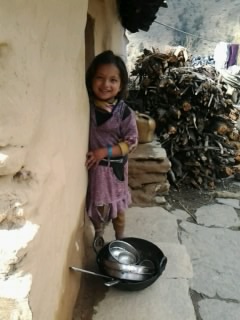
BACKGROUND
Fuel wood is the main source of energy for rural households. The Himalayan climate is a stark contrast between long, cold winters and warm wet summers. As a consequence, women and girls (as young as 4 years old) in the village of Jatoli spend at least 3 hours a day collecting wood for the dual use of heating and cooking in the colder months and cooking only in the monsoon season. According to local women elders the time taken to collect wood is increasing with every year. Consequently, the surrounding temperate rain forest is under pressure from over cutting for housing construction, livestock fodder/bedding and significantly fuel wood. The 10 kilometre collection zone falls within the Nanda Devi Biosphere Reserve recognised by UNESCO as being rich in biodiversity. The scarcity of timber proximal to villages has led to the practice of green wood collection.
The burning of solid biomass in the current metal tripod or ‘jat’ (pictured above) is regulated only by the amount, quality and moisture content that is used. This process has inherent loses through lack of controlled air flow in combustion and poor heat sink materials leading to inefficient wood use. Stoves used in similar climatic conditions in India, Pakistan and Nepal have shown a 30 to 35 percent reduction in fuel wood use.
Further inefficiencies occur with multiple dishes such as the staples of dhal and rice with roti cooked on a traditional jat which accommodates only one cooking vessel at a time. This becomes increasingly problematic if guests arrive for chai. That said, recent gas cylinders (for cooking only during the monsoon) have made inroads into the area but refilling cylinders is time consuming, problematic – mainly due to the remote geographic location - and expensive. This witnesses the few houses that have access to gas revert to wood, especially during the colder months were heating is paramount and ‘why pay, my wife’s labour is free!’
Nearly 70% of rural Indian households are classified as ‘unventilated’. WHO estimates that “pollution in rural Indian kitchens is 30 times higher than recommended levels” (Times of India 2013) Jatoli is no exception with small doorways and windows in the traditional houses designed for minimal heat loss (read: also minimal smoke loss). It is also recognised “in poorly ventilated dwellings indoor smoke can be 100 times higher than acceptable levels for small particles. Exposure is particularly high among women and young children whom spend the most time near the domestic hearth.” (WHO: fact sheets - 2013). PeAk staff note than when eating meals at local houses the air quality is so poor that it is frequently difficult to see the person sitting next to you, with the roof, walls and household goods (not to mention lungs) coated in black tar due to smoke.
The repeated exposure to household pollution from cooking with solid fuels (wood, animal dung, coal) is a major source of mortality responsible for 500, 000 premature deaths in India alone each year with most being women and children (approximately 3-4 million people globally). Wood smoke is a known carcinogen containing fine particulate matter, carbon monoxide, formaldehyde, benzene, sulphur dioxide and various irritant gases that scar the lungs. This indoor air pollution is a major source of acute respiratory infections, doubles the risk of childhood pneumonia, and is a leading cause of disease (stroke, ischaemic heart disease, lung cancer etc) and mortality. While morbidity and mortality statistics are difficult to quantify in the region, it is clear that significant health ramifications are a daily occurrence for the villagers with a high prevalence of childhood pneumonia, coughs, sore throats and wheezing being some of the most obvious effects of repeated smoke inhalation.
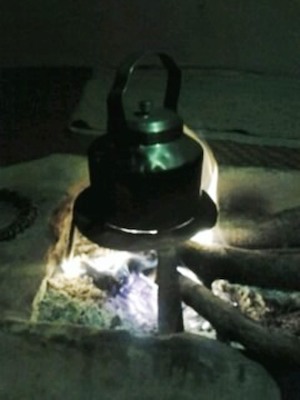
KEY AIMS
- Continue to liaise with local community members to integrate feedback into final design
- Provide local employment for those involved in the project
- Increase the cooking efficiency with a multiple dish cook top with roti door.
- Use primarily low cost and locally available materials where possible
- The use of thick steel for doors and frames will enhance the overall performance and longevity of the unit.
- Reduce fuel wood use by up to 30 per cent thus lightening the work load of women and girls and preserving the local forest environment.
- Provide a chulha that doesn’t substantially change the thermal efficiency of cooking.
- Increase the thermal efficiency of heating through re-radiation of heat sink materials in the mid-term.
- Alleviate indoor air pollution thereby improving the household health of all householders by reducing the rate of respiratory disease and premature death, especially of women and children.
- Reduce the black carbon (sooty particles) and methane emitted by inefficient stoves that are powerful climate change pollutants
- Supply an efficient fluepipe heating/cooking source that will stop the need for windows and doors to be left open in an attempt to eliminate smoke, thus being energy efficient.
- Improve knowledge and education in regards to the overall health and ecological ramifications of using the chulha.
In line with Millennium Development Goals the improvement of indoor air quality promotes environmental sustainability through less fuel wood use, frees up time spent cooking for income generating pursuits, reduces child mortality and improves maternal health (WHO 2014).